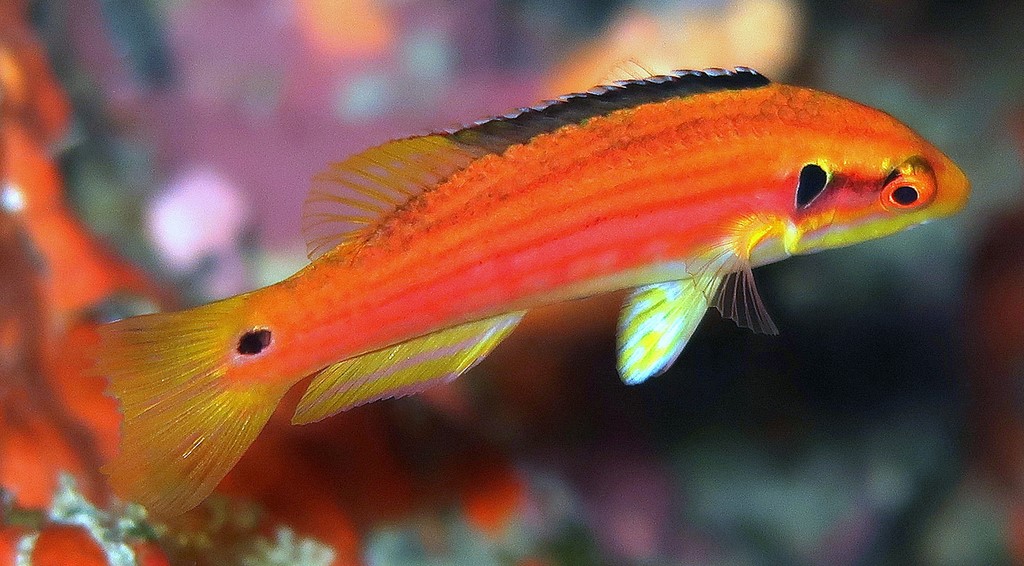BODIANUS BIMACULATUS - (ALLEN, 1973)
Picture courtesy of: Alain Daoulas
Labre à deux taches, Two-spot slender hogfish, Two-spotted hogfish, Twospot hogfish, Twospot pigfish, Yellow hogfish, Yellow Candy Hogfish, Futahoshi-kitsunebera, フタホシキツネベラ, 双斑普提鱼, 雙斑普提魚,
Description
Dorsal spines (total): 12; Dorsal soft rays (total): 9-10; Anal spines: 3; Anal soft rays: 11-12; Lateral-line scales: 30–31; Scales above lateral line: 3½; Scales below lateral line: ≈10 or 11; Predorsal scales: ≈8–10; Body and caudal peduncle of moderate depth; Snout of moderate length. Scaly basal sheath on dorsal and anal fins not more than 1 or 1½ scales deep. Posterior corner of mouth immediately posterior to vertical through forward extent of orbit. Upper jaw with first prominent anterior canine ≈½ to 1⁄3 length of second; About 4–12 small teeth on dental ridge; Usually single prominent canine at posterior end of jaw. Lower jaw with first prominent anterior canine ≈ ½ to 3⁄5 length of second; Teeth on dental ridge in a single row, usually separable into 2 series; First series of 6–9 teeth close behind anterior canines, small anteriorly, becoming progressively longer posteriorly, 6–10 uniformly short teeth in second series. One or two canines on vomer. Pelvic fin distinctly not reaching anus. Max. length: 10.0 cm TL. Depth range: 30 - 60 m.
Color
- Juveniles: yellow with narrow black line just above lateral midline from snout to below posterior portion of dorsal fin and large dark spot ocellated with paler yellow just above center of caudal-fin base. Black spot on operculum developing with growth. Medial fins yellow; Black spot at anterior end of dorsal fin; Caudal fin with posterior corners hyaline, making margin of pigmented area broadly pointed centrally. Paired fins hyaline.
- Initial-phase adults: body yellowish to pinkish with five narrow red stripes, underside of head and body below level of ventralmost stripe white. Dorsalmost red stripe originating anterodorsally on head, passing posteriorly just below dorsal-fin base to posterior end of fin base; Second stripe directed posteriorly from dorso-posterior edge of orbit to dorsal side of black spot on caudalfin base; Fourth stripe extending from dorsal corner of pectoral-fin base to caudal-fin base slightly below center of base; Fifth stripe running from center of pectoral-fin base posteriorly to lower fourth of caudal peduncle. Black spot ocellated in yellowish white or pink at base of caudal fin just above lateral line. Head pink to reddish above ventral edge of eye, white below; Large black spot rimmed with yellow dorsoposteriorly on operculum at posterior end of narrow reddish grey stripe directed posteriorly from posterior center of orbital edge; Reddish stripe directed posteroventrally from posteroventral edge of orbit to opercular edge; Broad yellow stripe directed posteriorly from upper lip and corner of mouth to opercular edge. Dorsal fin white with black spot between anterior 3 spines, continued posteriorly as grey submarginal streak on last 10 spines and intervening membranes, and broad yellow basal stripe with narrow submarginal yellow stripe; Fleshy tips of spines white. Anal fin white with broad basal yellow stripe and broad submarginal yellow stripe. Caudal fin white with 5 angled longitudinal yellow stripes; Midlateral stripe narrow, remaining 4 broad; Dorsal-most and ventralmost stripes diffuse distally. Pectoral fin transparent with broad yellow band on fleshy base extending onto proximal ends of rays. Pelvic fin white with elongate yellow spots and marks.
- Terminal-phase adults: lemon yellow or mostly scarlet above lower edge of pectoral-fin base and white below; Scarlet individuals with coloration intensified in those areas corresponding with stripes described for initial-phase adults; Yellow individuals with mauve stripe midlaterally on head and sides, overlain with large red patchlike spots extending ventrally on sides and faint reddish brown stripe just above from rear edge of eye to caudal-fin base; Black opercular spot as described for initial-phase adult. Spinous portion of dorsal fin with black submarginal stripe expanded to cover membranes between first three spines, bright blue distal margin, and grey basal portion; Soft portion of fin with broad yellow submarginal and basal stripes. Anal fin yellow with broad blue submarginal stripe. Caudal fin mostly yellowish. Pelvic fin bluish white with lengthwise elongate golden blotches.
Etymology
Bodianus: after Bodiano or Pudiano, from the Portuguese pudor, meaning modesty (Jordan & Evermann, 1896).
bimaculatus: from Latin prefix, bi- = having two parts, occurring twice + from Latin, macula, -ae = stain, spot. Referring to its characteristic black spots on the opercle and caudal peduncle.
Original description: Bodianus bimaculatus Allen, 1973 - Type locality: vertical dropoff at Bairakaseru Island, Ngemelis Islands, Palau Archipelago, Philippine Sea, depth 42 meters.
Distribution
Red Sea; Indo-West Pacific: KwaZulu-Natal (South Africa), Madagascar, Mascarenes (Mauritius), eastern Indonesia east to Palau and New Ireland (Papua New Guinea), north to southern Japan, south to New Caledonia and northern New Zealand.
Bodianus: after Bodiano or Pudiano, from the Portuguese pudor, meaning modesty (Jordan & Evermann, 1896).
bimaculatus: from Latin prefix, bi- = having two parts, occurring twice + from Latin, macula, -ae = stain, spot. Referring to its characteristic black spots on the opercle and caudal peduncle.
Original description: Bodianus bimaculatus Allen, 1973 - Type locality: vertical dropoff at Bairakaseru Island, Ngemelis Islands, Palau Archipelago, Philippine Sea, depth 42 meters.
Distribution
Red Sea; Indo-West Pacific: KwaZulu-Natal (South Africa), Madagascar, Mascarenes (Mauritius), eastern Indonesia east to Palau and New Ireland (Papua New Guinea), north to southern Japan, south to New Caledonia and northern New Zealand.
Biology
Adults are common around rubble and sand in steep outer reef slopes, and drop-offs, usually adjacent to very deep water. They form small aggregations in soft bottom habitats with sponges and soft corals. The group usually comprising juveniles and females which are dominated by a large male. Oviparous, distinct pairing during breeding. It can be found in the aquarium trade.
Similar species
Bodianus sanguineus (Jordan & Evermann, 1903) - Reported from Hawaiian Islands. Differ from Bodianus bimaculatus by fewer lateral line scales.
Halichoeres chrysus (Randall, 1981) - Reported from New Caledonia - Link to the species (here).
Last update: 15, March 2023
